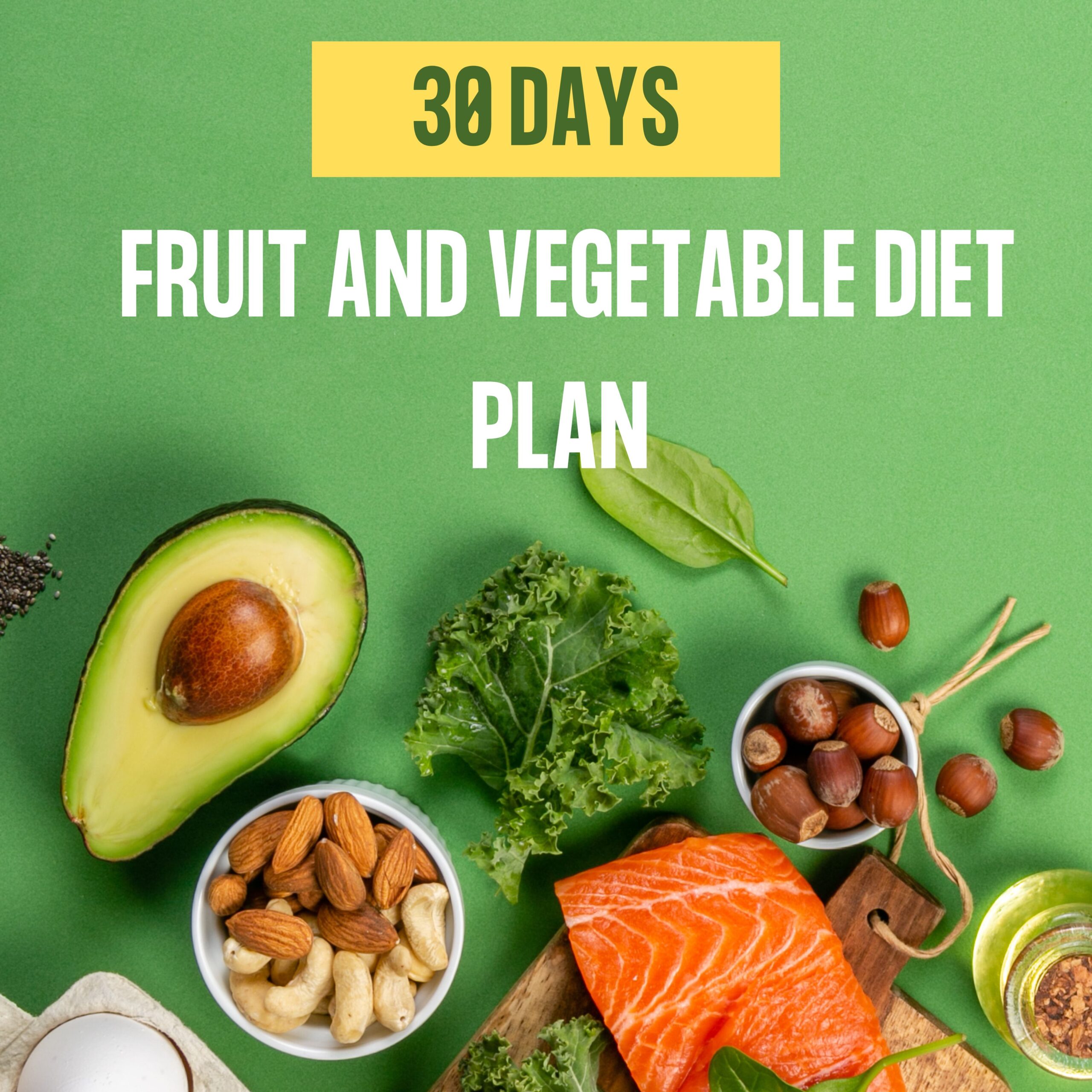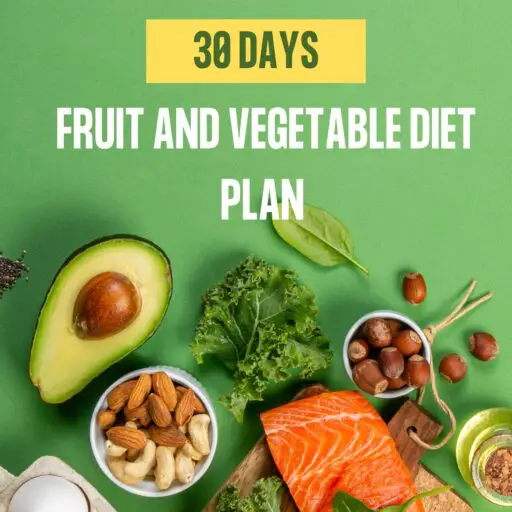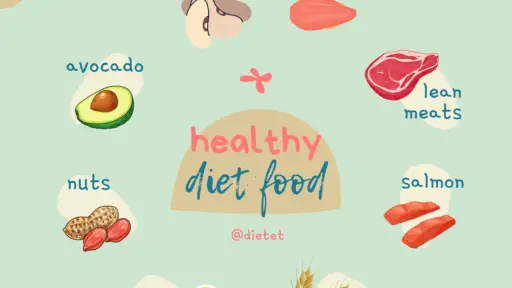30-day fruit and vegetable diet plan: Proven
Welcome to your new journey towards a healthier, fuller life! Have you ever stopped to wonder about the incredible power fruits and vegetables hold for our well-being? Packed with vitamins, minerals, and fiber, yet low in fat and calories, these nutrient bombs are your secret weapon to feeling and looking amazing. We’re embarking on a 30-day fruit and vegetable diet plan that is about to change your life for the better. The key is not deprivation, but abundance. This is not just a diet, but a celebration of nature’s bounty. So, are you ready to revolutionize your health, one bite at a time?
“When diet is wrong, medicine is of no use. When diet is correct, medicine is of no need.” – Ayurvedic Proverb
Embark with us on this enriching path, discovering not only healthier food habits but a whole new perspective towards your lifestyle. Here’s to thirty days of wholesome, naturally vibrant food and the myriad of benefits they promise to bring. Let’s dive into this cornucopia of vitality together!

How can I use 30-day fruit and vegetable diet plan?
To embark on a fruit and vegetable diet, make lifestyle adjustments that prioritize these nutrient-packed food groups. Here are some actionable tips:
Firstly, make your fruits visible. Openly display a bowl of colorful fruits on your kitchen counter or your dining table. When fruits are within your sight, you are more likely to reach for them when hunger strikes.
Second, snack smart. Keep chopped fruits and veggies in easily accessible places like your fridge or on your desk. Consider packing them in your bag before you leave for work or school. Doing so will encourage you to pick these healthier options over the usual processed snacks.
When it comes to creating meals, incorporate a rainbow of fruits and vegetables into your dishes. This not only makes your meals visually appealing but also ensures you get a variety of essential nutrients. Apples, blueberries, mangoes, and pineapples are great fruit options. For vegetables, consider spinach, carrots, and broccoli.
Embrace the versatility of fruits and vegetables by trying them in different forms: fresh, frozen, canned, dried, or juiced. Whether you enjoy a fresh apple or prefer a glass of apple juice, all count towards your daily target.
Adopting a fruit and vegetable diet doesn’t mean you have to give up all your favorites immediately. A gradual transition might be more successful.
For instance, you can start by modifying the proportion of fruits, vegetables, and other items in your meals. Reduce high-energy-density foods such as fries gradually, replacing them with vegetables or fruits. This simple change will increase your fruit and vegetable intake significantly and create a healthier eating pattern.
Remember, the ultimate aim of a fruit and vegetable diet is to improve your health, so make sure you keep a balanced and varied diet to reap all the potential benefits.
What are some easy recipes for a fruit and vegetable diet plan?
Embarking on a 30-day fruit and vegetable diet doesn’t mean you’ll be stuck with bland meals or endless bowls of salad. With a little creativity, you can cook up delicious, nutrient-packed meals and snacks that appeal to your taste buds. Here are some easy and exciting recipes to try.
Fruit and Veggie Smoothie
Packing in a wide variety of fruits and vegetables in a single glass is an effortless way to boost your daily intake. To prepare a fruity, refreshing smoothie, blend together a cup of spinach, half a banana, a handful of blueberries, and a splash of almond milk. If you prefer it a bit sweeter, add some honey. It’s nutritious, delicious, and cool — perfect for hot summer days.
Roasted Vegetable Medley
Take advantage of the natural flavors of vegetables by roasting them. Toss a mix of your favorite vegetables — such as broccoli, carrots, and bell peppers — in olive oil, sprinkle with herbs and spices of your choice, and roast until tender. Paired with a serving of grilled chicken or fish, you have a satisfying main meal.
Fruit Salad
Give a classic fruit salad an interesting twist. Combine chunks of apples, mango, and pineapple, then sprinkle with a handful of blueberries. Drizzle with a squeeze of fresh lime juice and sprinkle with fresh mint to add zing to the natural sweetness of the fruits.
Frozen Veggie Stir Fry
Don’t overlook the frozen aisle the next time you shop for your fruit and vegetable diet. Frozen vegetables can be a budget-friendly way to ensure you always have veggies on hand. Whip up a quick stir fry using frozen mixed vegetables, a splash of low-sodium soy sauce, a touch of garlic, and a sprinkle of sesame seeds for added crunch.
These recipes are just a starting point. Feel free to mix and match fruits and vegetables to suit your preference. After all, enjoying what you eat is key to making this 30-day diet plan a sustainable lifestyle change.
Are there any risks associated with a 30-day fruit and vegetable diet?
The concept of a risk with a 30-day fruit and vegetable diet could sound a bit perplexing. After all, fruits and vegetables are paramount for a healthy diet, aren’t they? They are indeed, and no one can deny their crucial role in promoting health. However, transitioning abruptly to a diet consisting primarily of fruits and vegetables might be a significant change for your body, particularly if your previous dietary habits weren’t so greener. So yes, potential risks can be a concern, particularly when this diet is not approached properly.
One potential fallout could be lack of sufficient protein. Fruits and vegetables, though nutrient-rich, are not high in protein, a critical nutrient for muscle growth, tissue repair, and other bodily functions. This could result in feeling weak, loss of muscle mass and strength if you do not compensate for this loss.
Moreover, limiting your diet predominantly to fruits and vegetables might deprive you of other essential nutrients coming from diverse food groups like whole grains, fats, and dairy. For instance, omega-3 fatty acids, typically found in fatty fish, are essential for cardiovascular and cognitive health but are largely absent in fruits and vegetables. Similarly, relying solely on plant-based foods might result in deficiencies in vitamins like B12, a nutrient vital for nerve function and the formation of red blood cells, typically sourced from animal products.
Also, switching directly to a 30-day fruit and vegetable diet plan can lead to digestive distress in some. This sudden increase in fiber intake can result in bloating, gas, and in some extreme cases, constipation.
Finally, for those with specific health conditions such as diabetes, a diet high in fruits can potentially elevate blood sugar levels due to their natural sugar content – fructose.
However, these risks can be mitigated with proper planning and execution, ensuring you balance your intake with other food groups to prevent nutritional deficiencies. Use the 30-day period as a stepping stone to incorporating more fruits and vegetables into your daily meals, rather than an abrupt dietary overhaul. Always consult with dietitians or nutritionists for a customized plan that will fit your nutritional needs and lifestyle.
Know more about 7 Days Diet Plan
How much fruit and vegetables should I eat daily on this diet?
You’re probably curious to know exactly how much fruit and vegetables you should be eating every day to fully reap the rewards of this diet plan. According to the current USDA guidelines, it’s recommended that most people consume about 2 cups of fruits and a full 3 cups of vegetables every single day. However, the World Health Organization (WHO) advises a minimum intake of 400 grams of these nutrient powerhouses, to lower the risk of serious health problems.
But let’s put that into perspective. What do these recommendations look like on your plate? Practically, this could look like five portions spread across various meals and snacks during your day. Remember, variety is crucial. So, try to include a wide array of fruits and vegetables to your diet for a balanced intake of vitamins, minerals and dietary fibers.
Need an incentive? Let’s talk about the significant positives of reaching your ‘5 a day’ quota. First off, fruits and vegetables are excellent sources for essential vitamins and minerals. They also provide dietary fiber, which could substantially reduce your risk of bowel cancer. Furthermore, consuming enough of these can aid in reducing the risk of heart disease, stroke, and even some types of cancer. And let’s not forget that they contribute to a healthy, balanced diet, keeping you in tip-top shape!
Read More: How to Diet with Fruits?
Can a fruit and vegetable diet improve my skin health?
Oh, the glorious benefits of fruits and veggies—they’re not just for your internal health! Have you ever considered how this vibrant food group might influence your skin’s radiance? Just as a rainbow of fruits and vegetables boosts overall wellness, its impact on the complexion is equally fantastic. Read on as we delve into how a 30-day diet plan packed with these nutritional powerhouses could culminate in a youthful, glowing skin you’ve always dreamed of.
Charming Carrots and Beautiful Broccoli: Your Skin’s Best Friends
Nature has some stellar skin enhancers. Carrots, filled with vitamin A, are renowned for their support of healthy skin. This nutrient, also found in abundance in broccoli, aids in reducing oils in the skin, thus helping to prevent acne outbreaks. But it doesn’t stop there! Ever heard of ‘glow’ nutrients? Both carrots and broccoli are packed with antioxidants and vitamins such as C and E that are known to promote radiant skin.
Welcoming Apples and Marvelous Mangos to Your Skin Care Regiment
Apples and mangos are another duo that deserves a spotlight in your skincare regime. These fruits are brimming with vitamins A and C – ‘rejuvenating nutrients’, if you will – that stimulate collagen production, a protein vital for skin elasticity and firmness. Added bonus? The high water content in these fruits may contribute to skin hydration, supporting plumpness and reducing the noticeable appearance of wrinkles.
Fighting Free Radicals with Blueberries and Pineapples
Blueberries and pineapples bring their unique bounty to the table, as well. Blueberries, with their high concentration of antioxidants and vitamin C, are essentially front-line guardians against free radicals that expedite aging. Pineapples are also allies worth having, with their rich magnesium content that promotes skin barrier function and hydration.
In conclusion, embracing a 30-day fruit & vegetable diet plan laden with variety of fruits and vegetables can do wonders to your skin health. It’s nature’s way of offering you a shot at maintaining youthful, radiant skin. Alongside skin benefits, remember these colorful foods are also critical in warding off various diseases, boosting your digestive health and overall life longevity. With the mouthwatering recipes and tips you’ve gathered from this article’s sections, you’re now equipped to start a journey towards a healthier body and rejuvenated skin.
Final Thought
As we wrap up, it’s vital to remember that shifting to a 30-day fruit and vegetable diet isn’t just about weight loss. This lifestyle change boasts multiple health benefits, from improving your skin health to potential disease prevention. However, although fruits and vegetables are undeniably beneficial, it’s crucial not to entirely eliminate all other food groups from your eating habits. Your body needs a balanced blend of carbohydrates, protein, and fats to function optimally.
The key to a successful fruit and vegetable diet lies in variety. Endeavour to explore a broad range of fruits and veggies – don’t just limit yourself to apples or tomatoes. Consider trying lesser-known fruits like pomegranates or vegetables like broccoli rabe; you might be pleasantly surprised!
Remember, how much fruit and vegetable diet plan you should consume daily is still a topic under discussion. While some studies suggest five servings a day, others argue for an even higher intake. Listen to your body and adjust appropriately according to your personal health needs and goals. Follow-up counseling, as stated by Bensley et al., can be helpful in achieving your desired F&V intake levels.
Finally, it’s important to note that any significant diet adjustment should be undertaken with guidance from a healthcare professional. So, before embarking on a 30-day fruit and vegetable journey, be sure to consult your doctor or a dietitian to ensure you’re making the best choices for your unique health circumstances.
Here’s to embarking on your exciting fruit and vegetable journey. Best of luck, friend with your Fruit and Vegetable Diet Plan





